目录
- 当前需求: 实现 Student 继承自 Person
- 构造函数Person
- 构造函数Student
- 希望满足的条件功能
- 利用原形链实现方法的继承
- 方式1: 子类原型指向父类原型
- 方式2 子类原型指向父类实例对象
- 借用构造函数继承
- 方式3 组合继承
- 寄生式继承
- 思路
- 最终 方式4: 寄生组合式继承
- 附: 扩充createObject
当前需求: 实现 Student 继承自 Person
如果手动实现继承效果, Person和Student分别写自己的属性和方法, 两个构造函数之间没有任何关联
- 代码编写繁琐
- 可维护性低
构造函数Person
| function Person(name, age, height, address) { | |
| this.age = age | |
| this.height = height | |
| this.address = address | |
| } | |
| Person.prototype.running = function() { | |
| console.log("running~") | |
| } | |
| Person.prototype.eating = function() { | |
| console.log("eating~") | |
| } |
构造函数Student
| function Student(name, age, height, address, sno, score) { | |
| this.age = age | |
| this.height = height | |
| this.address = address | |
| this.sno = sno | |
| this.score = score | |
| } | |
| Student.prototype.running = function() { | |
| console.log("running~") | |
| } | |
| Student.prototype.eating = function() { | |
| console.log("eating~") | |
| } | |
| Student.prototype.studying = function() { | |
| console.log("studying~") | |
| } |
内存图
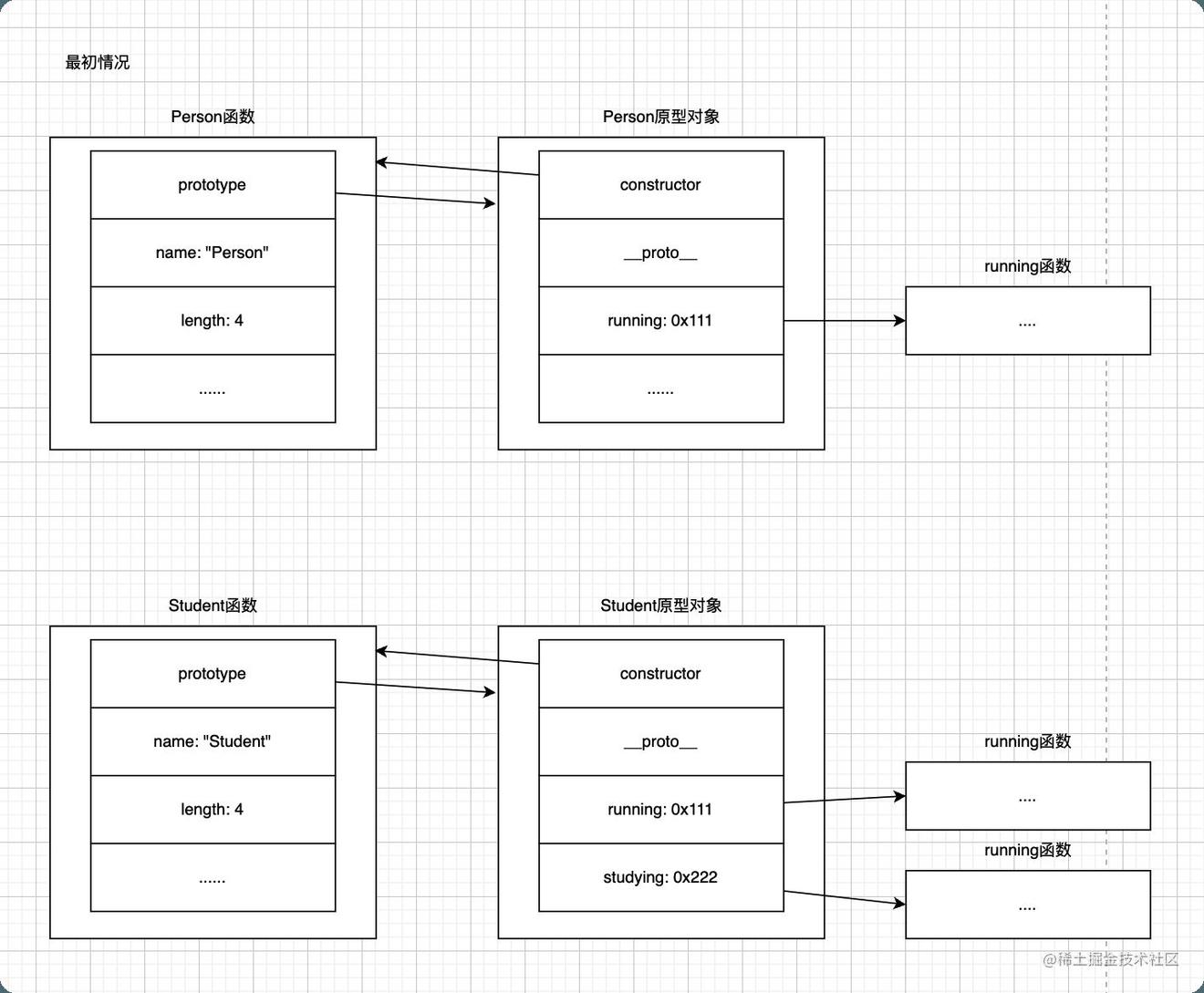
希望满足的条件功能
Student构造函数满足以下条件
- 能够重写继承的方法, 但不修改Person原型上的方法.
- 能够增加方法, 但不会影响Person原型上的方法.
Student构建出的实例对象满足以下条件
- 有name, age, height, address属性, 并且扩充sno和score. 作为自己独立的属性.
- 继承running, eating方法, 和Person实例对象的方法有相同的引用.
利用原形链实现方法的继承
方式1: 子类原型指向父类原型
| function Student(age, height, address, sno, score) { | |
| this.age = age | |
| this.height = height | |
| this.address = address | |
| this.sno = sno | |
| this.score = score | |
| } | |
| + Stuednt.prototype = Person.prototype |
内存图
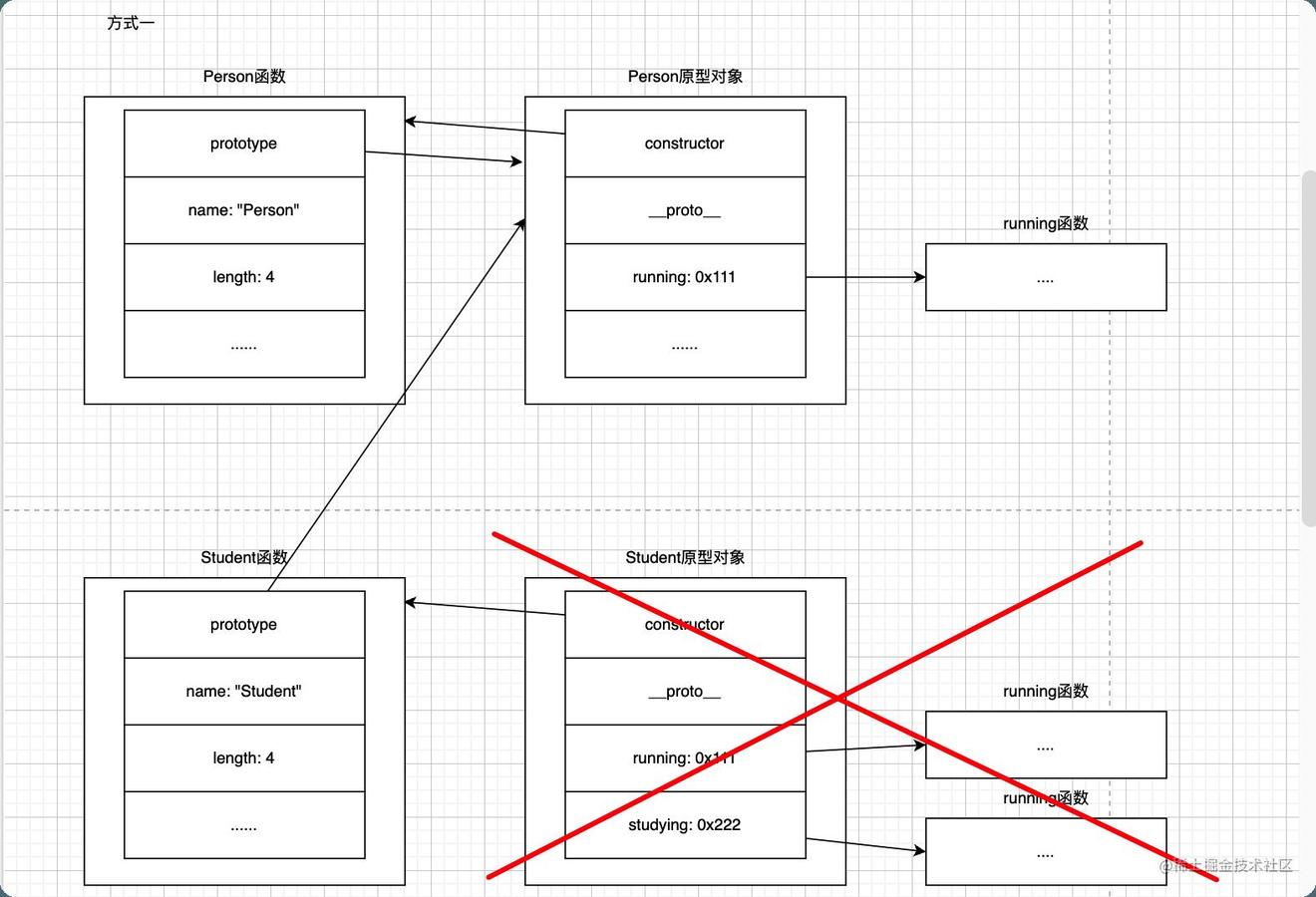
缺点
父类和子类共享通一个原型对象, 修改了任意一个, 另外一个也被修改
方式2 子类原型指向父类实例对象
| function Student(sno, score) { | |
| this.sno = sno | |
| this.score = score | |
| } | |
| + var p = new Person() | |
| + Student.prototype = p |
内存图
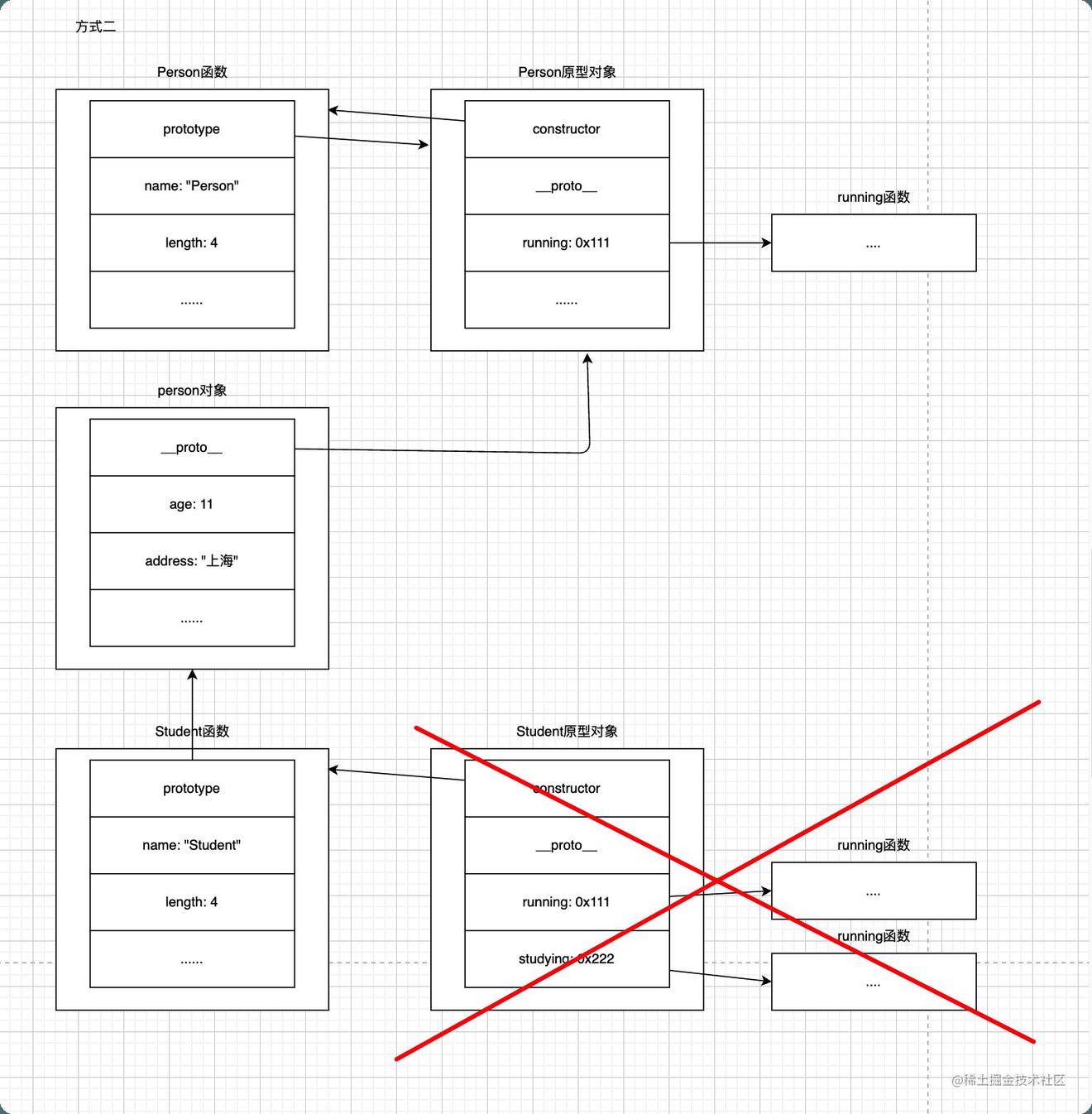
缺点
- 属性放在了原型上, 无法通过打印查看.
- 创建的多个实例对象, 继承的属性不互相独立, 一个实例对象修改属性影响其他的实例对象
- 要new一个实例, 怪怪怪怪怪怪
借用构造函数继承
方式3 组合继承
| function Person(name, age, height, address) { | |
| this.name = name | |
| this.age = age | |
| this.height = height | |
| this.address = address | |
| } | |
| Person.prototype.running = ... | |
| function Student(age, height, address, sno, score) { | |
| + Person.call(this, age, height, address) | |
| this.sno = sno | |
| this.score = score | |
| } | |
| Student.prototype = new Person() |
内存图
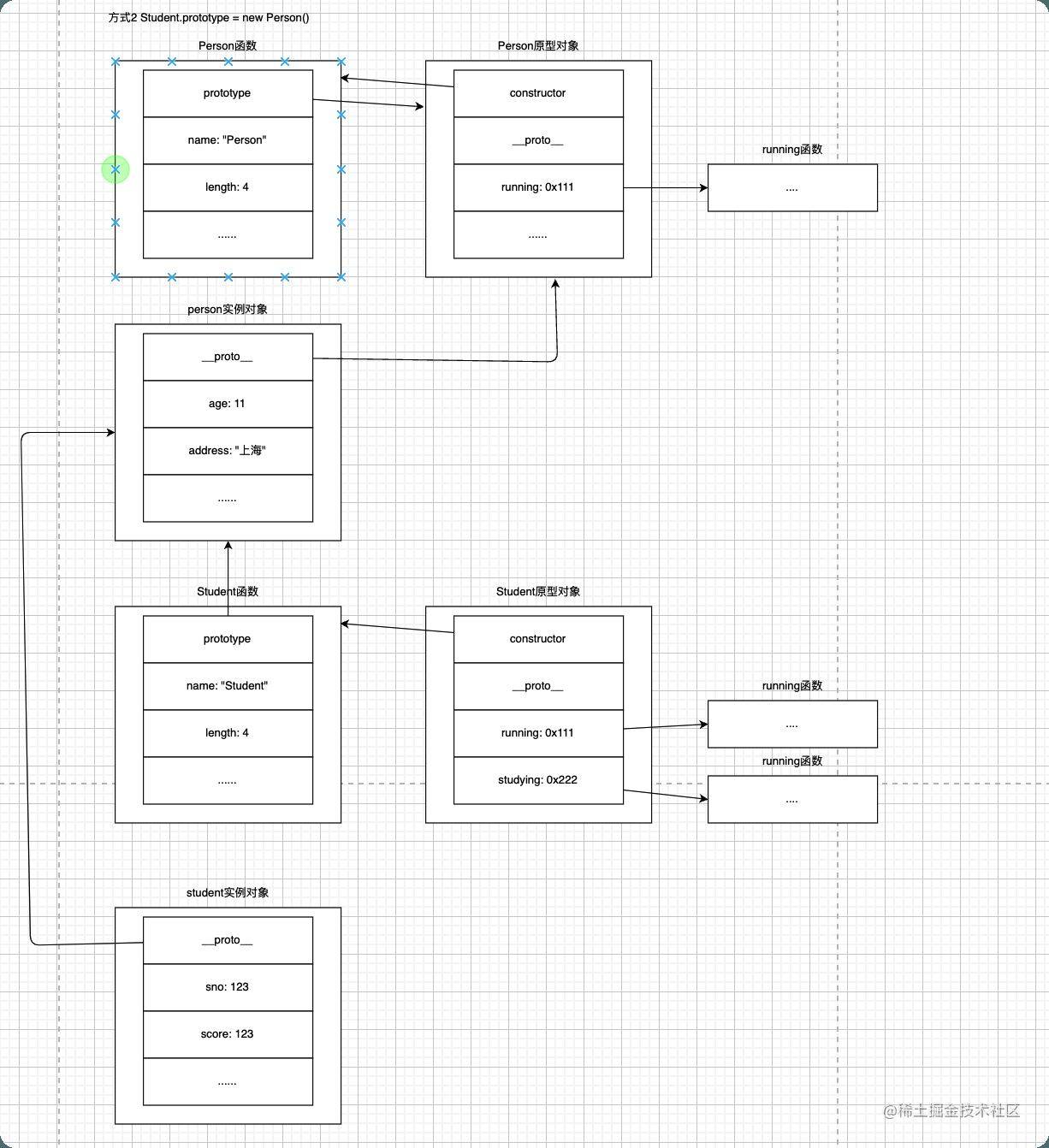
优点
解决之前的硬性问题, 实例对象属性独立, 属性放在对象内而不是原型上.
缺点
- 调用两次父类的构造方法, 性能浪费
Student.prototype = new Person()第一次Person.call(this)第二次- 调用两次构造方法, 导致子类创建的实例对象上, 保留了两份父类的属性
- 一份在实例对象的
__proto__上, new时产生的 - 一份在实例对象上, 通过借用构造方法call得到
寄生式继承
思路
属性的继承已经解决, 通过Person.call(this) 解决.
方法的继承未解决, 需要找到 Student.prototype = new Person() 的替代方案
思路1
| var obj = {} | |
| obj.__proto__ = Person.prototype | |
| Student.prototype = obj | |
| // __proto__为浏览器增加的属性, 解决浏览器兼容性问题可以改为 | |
| var obj = {} | |
| Object.setPrototypeOf(obj, Person.prototype) | |
| Student.prototype = obj |
思路2
兼容所有浏览器 解决老版本浏览器不支持setPrototypeOf
| function F() {} | |
| F.prototype = Person.prototype | |
| Student.prototype = new F() |
思路3
Object.create() 传入一个对象作为参数, 并返回一个对象, 返回的对象的原型为传入对象
| var obj = Object.create(Person.prototype) | |
| Student.prototype = obj |
最终 方式4: 寄生组合式继承
| // 工具函数 | |
| // 创建对象的过程 | |
| function createObject(proto) { | |
| function F() {} | |
| F.prototype = proto | |
| return new F() | |
| } | |
| // 将Subtype和Supertype联系在一起 | |
| // 寄生式函数 | |
| function inherit(Subtype, Supertype) { | |
| Subtype.prototype = createObject(Supertype.prototype) | |
| Object.defineProperty(Subtype.prototype, "constructor", { | |
| enumerable: false, | |
| configurable: true, | |
| writable: true, | |
| value: Subtype | |
| }) | |
| } | |
| function Student(age, height, sno, score) { | |
| Person.call(this, age, height) | |
| this.sno = sno | |
| this.score = score | |
| } | |
| + inherit(Student, Person) | |
| // 使用方法 | |
| Student.prototype.studying = function() { | |
| console.log("studying") | |
| } |
💡 使用Person.call实现属性的继承
💡 使用inherit实现方法的继承
createObject使Student.prototype指向Person的prototype, 但中间多一个构造函数F(), 解决方式1 的问题Object.defineProperty实现Student.prototype的constructor属性指回Student构造函数.内存图
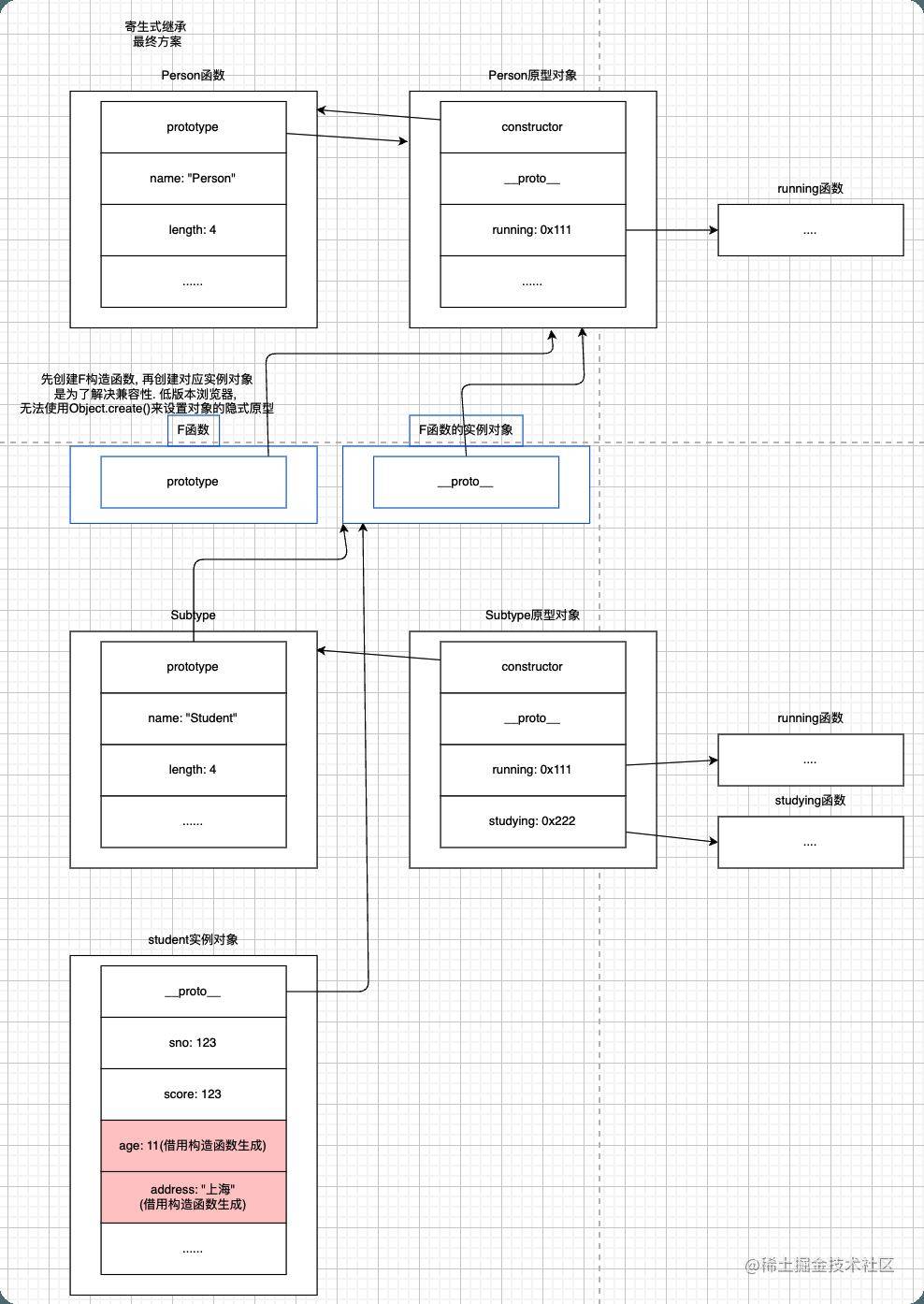
附: 扩充createObject
最初的设计思想, 是为了实现对象的继承, 所以有了以下的代码
createObject只能够做到构造一个有原型的空对象, 现在想要让构造的对象也有属性
| createInfo(proto, age, height) { | |
| const newObj = this.createObject(proto) | |
| newObj.age = age | |
| newObj.height = height | |
| return newObj | |
| } |